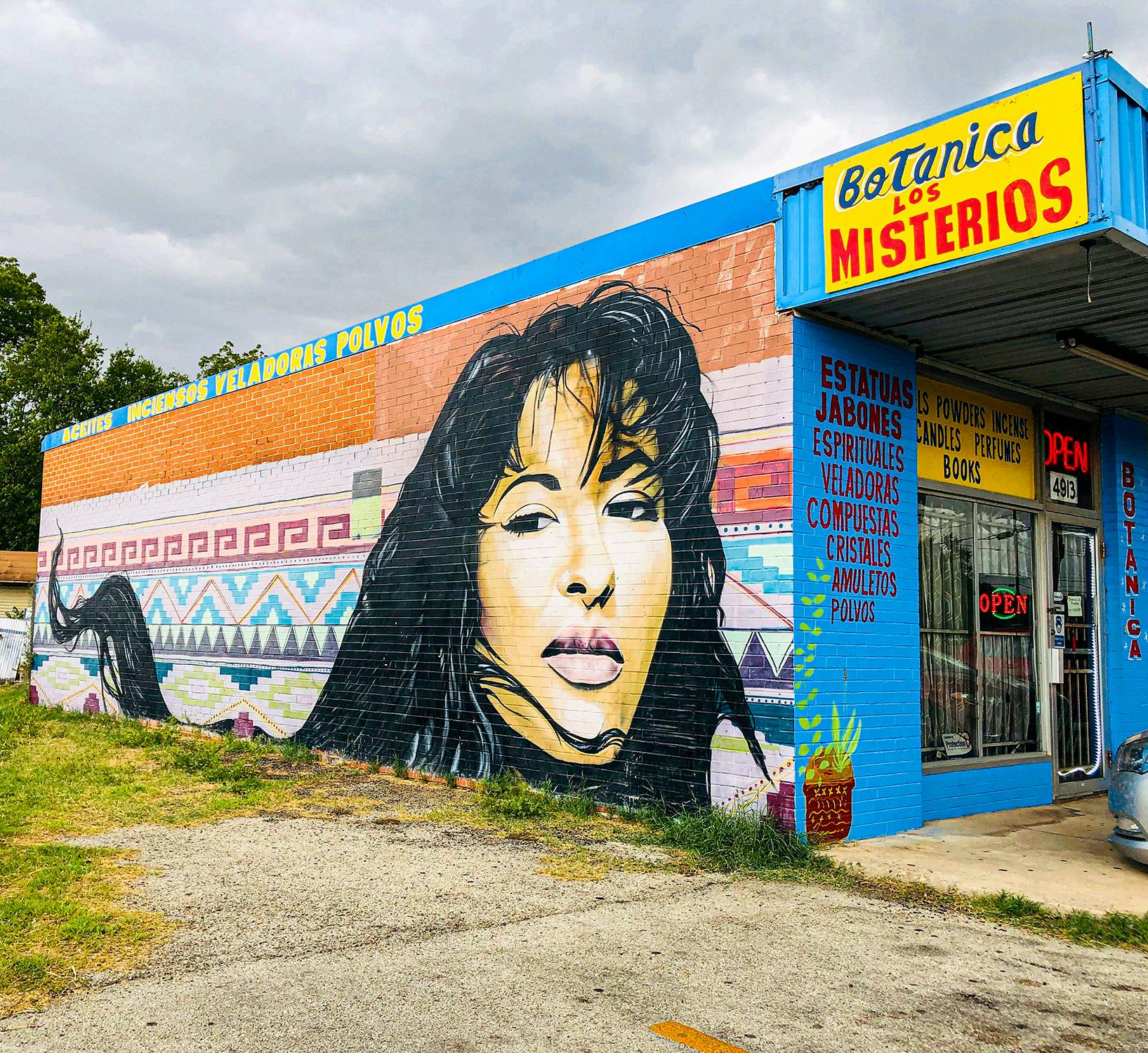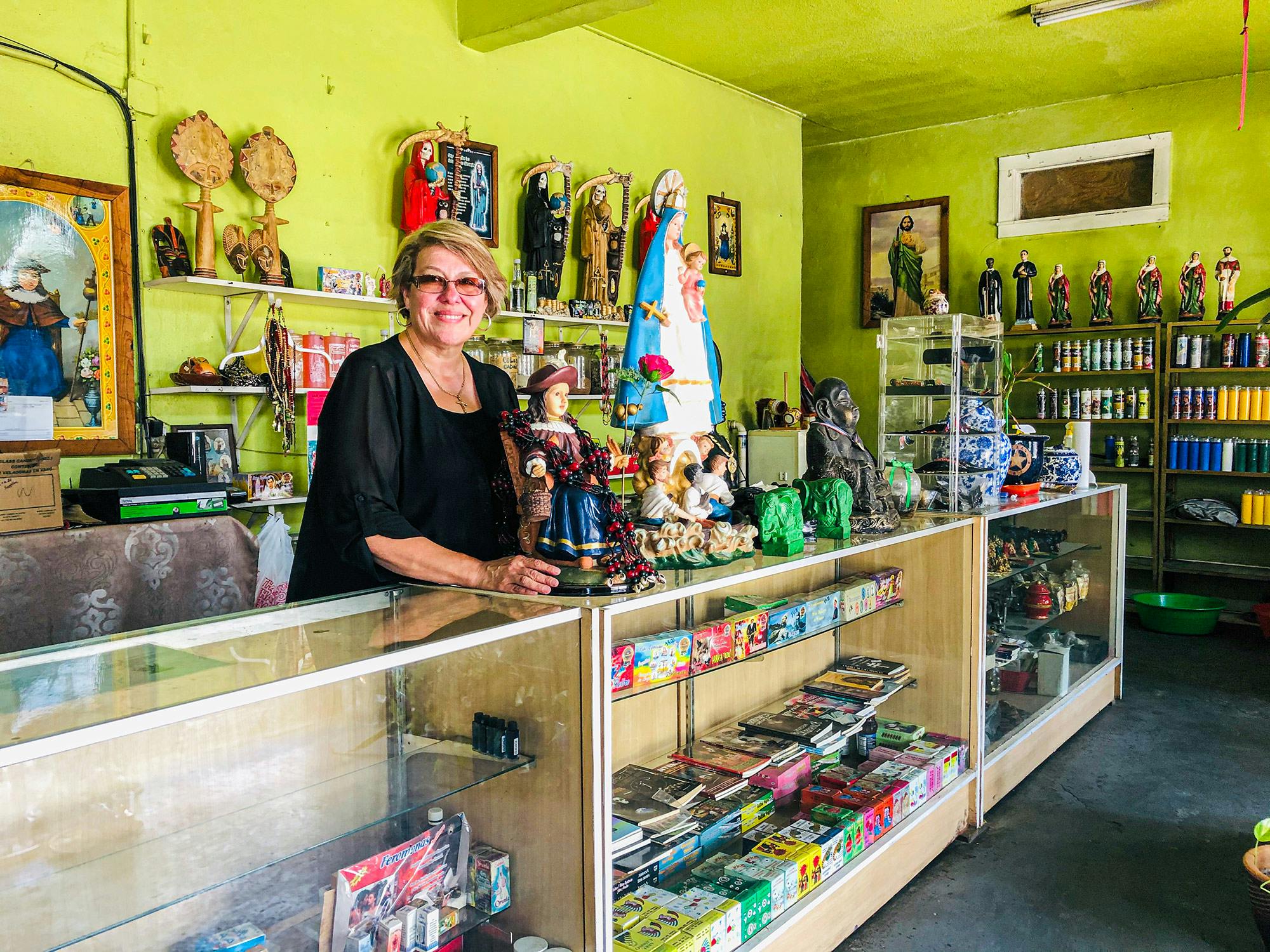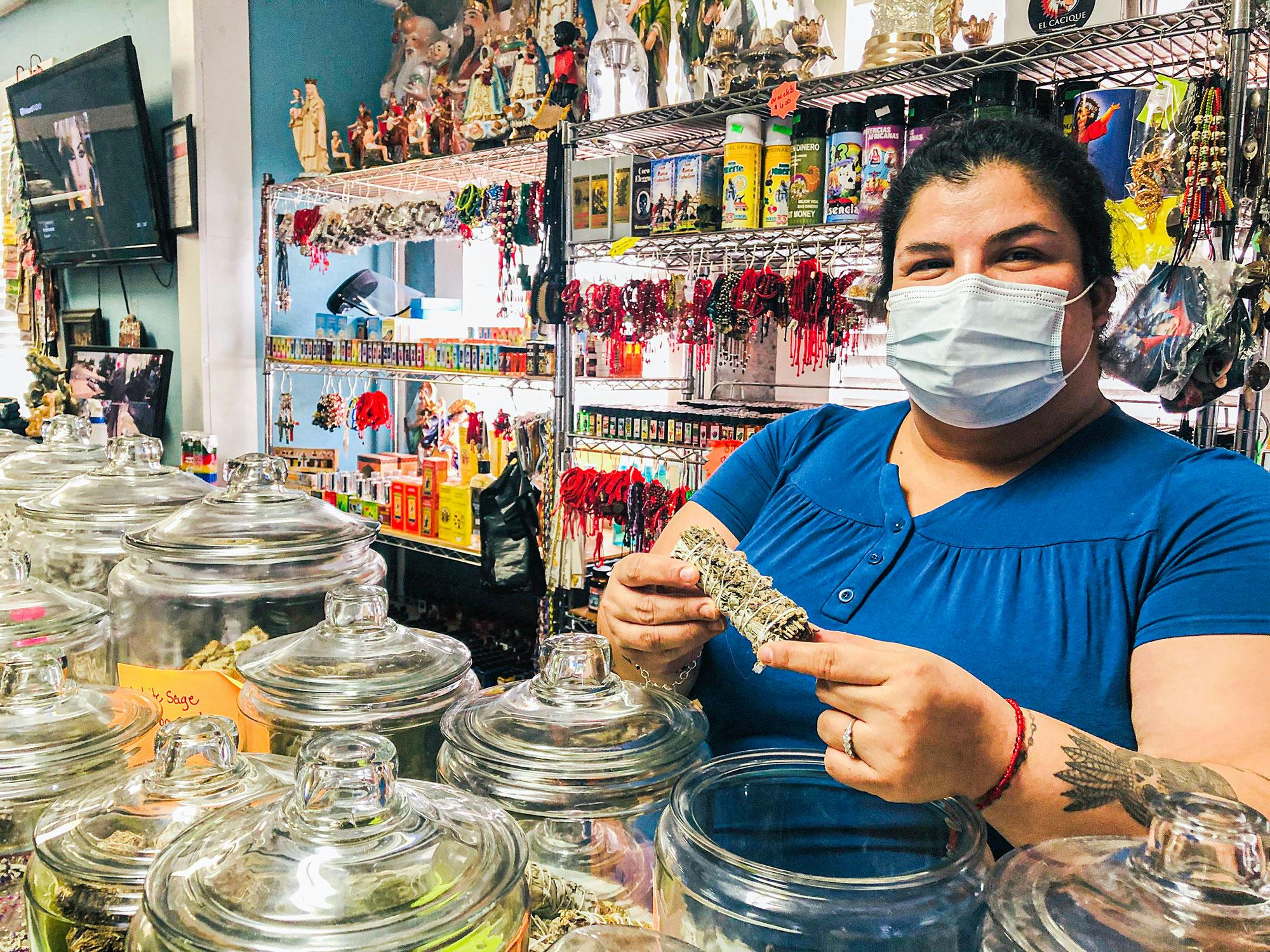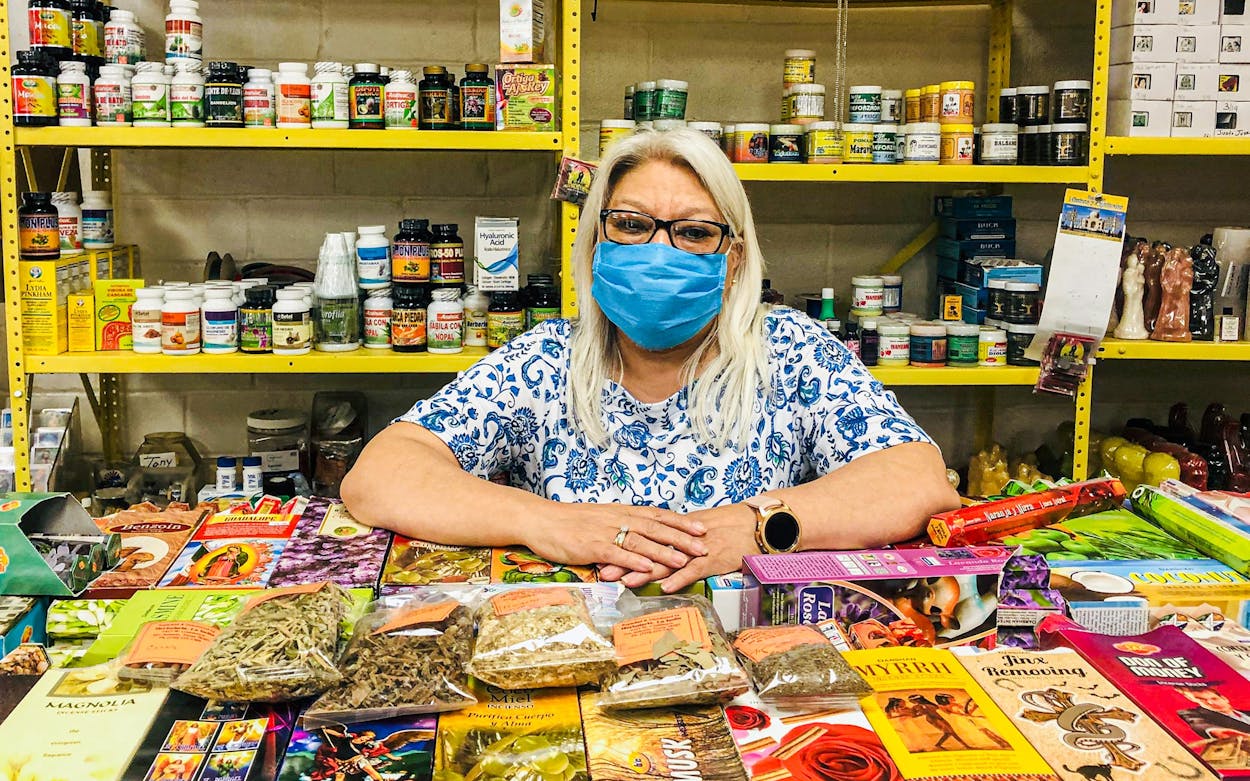The Botanica Los Misterios sits at the end of a strip mall in a working-class neighborhood of San Antonio’s South Side, next to a shoe repair shop and a store selling mariachi accessories. If not for a dazzling mural of Selena flowing down the side of the building, the Botanica’s light blue storefront could be easily missed from South Flores Street, a busy roadway that cuts through the southern half of the city.
On a recent afternoon, the owner, a soft-spoken, balding man in his mid-40s, was getting ready to lock up the tiny store when Marisa Casanova walked in the front door, a look of worry on her face. The 47-year-old patron, who grew up nearby and works as a caretaker, held a crumpled $10 bill in her hand—enough, she hoped, to pay for a miracle.
After a months-long stint in the county jail and a county rehab facility, her 21-year-old son was scheduled to come home at the end of the month. In any other year, his release would be a cause for celebration. But with both facilities battling COVID-19 outbreaks in recent months, his return could mean a potential disaster, especially for Casanova’s 78-year-old father and her diabetic sister on dialysis, both of whom live in the same home. Lacking health insurance and unable to pay for a preemptive doctor’s visit, Casanova decided instead to come to her neighborhood botanica, where she hoped to find a natural remedy capable of ridding her son of the coronavirus and other illnesses that she worried he may have picked up in jail. It was a last resort, she admitted, but she had few options left.
“Whatever it takes,” she said after purchasing a bag of “Gordolobo,” an herbal product that contains a Mexican flower that has been used for thousands of years to make a tea to treat respiratory ailments, including asthma and pneumonia. “Right now he doesn’t have any symptoms, but I’m going to ask him to drink this tea when he comes home as a way of cleansing him.”

Typically found in Latino neighborhoods, botanicas sell medicinal herbs, incense, oils, religious paraphernalia, and spiritual guidance. Inside, the stores are brightly colored and often crowded with merchandise that draws from spiritual traditions in Africa, the Middle East, Europe, and the United States. The herbs and spices are for everything from treating an upset stomach to reinvogorating an ailing sex life to navigating a messy divorce. But for months now, as nearly 48,000 people in Bexar County have contracted the coronavirus, and nearly 1,200 have died, botanicas across San Antonio have taken on a new role: the last line of defense for the city’s vulnerable and virus-stricken residents as they struggle to cope with the pandemic. They arrive daily, botanica owners say. Many have little to no access to the health care system—no surprise given that nearly 20 percent of Hispanic San Antonians are uninsured, according to the United States Census Bureau. Most are hoping to treat loved ones sickened by the deadly virus, often in multigenerational households where COVID-19 is easily passed among family members.
“People have been coming here and saying, ‘My tía is sick and I have to quarantine her. What can I use to divide up the house so that we don’t get sick in this other part of the house?’” said Monica Vidaurri, the owner of Botanica La Caridad, just outside downtown San Antonio, and who caught the coronavirus from her asymptomatic stepdaughter. “The answer is saging. We tell them to sage the entire house.”
Before the pandemic Vidaurri used to stock up on sage about once a month. Now, the shop runs out of the herbaceous plant every two weeks. “Everyone is asking for it and they want different scents—lavender, cinnamon, or rosemary,” she added.
Some botanica owners agree to meet with COVID patients, usually privately and outdoors, but others ask the individual to send a healthy relative in their place. Vita, the 64-year-old owner of Botanica Miracle Hand, located on the South Side, says she’s possessed psychic abilities since she was a little girl and told me she can discern whether someone is carrying the virus by looking at them, but she can’t cure them. Vita tells COVID patients to seek treatment at the hospital, something few can afford.
“When they come in they’re desperate and they’re looking for hope,” said Janet Zenteno, a fourth-generation healer and the owner of Botanica Eshu Aniki on the West Side who estimates she sees about a dozen people a week dealing with COVID in some capacity. Zenteno is one of the few owners I spoke to who will meet with a sick patient in person, though she wears a mask and practices social distancing. “They’re scared. You can see the fear on their face.”
Zenteno tells her customers to load up on vitamin C, sunshine, and hot liquids. The goal, she claims, is to raise the body’s temperature until it’s inhospitable for the virus. For those looking for a more aggressive way to kill the virus she offers a novel—and potentially dangerous—solution: inhaling the hot air from a hair dryer to kill the virus deep inside the respiratory tract. Asked what compels her customers to inhale blasts of piping hot air instead of going to a hospital, Zenteno says: “They don’t have money for the doctor,” she explained. “A single appointment can be hundreds of dollars and then you factor in the cost of medication—that’s what really gets people.”

Despite incomplete data, researchers say, there is no doubt that Latino communities across the state have suffered the most brutal effects of the coronavirus pandemic. Texas is the only state where Latinos account for more than half of all deaths from COVID-19, according to Rogelio Sáenz, a professor in the department of demography at the University of Texas at San Antonio. In a recent column, Sáenz pointed out that the virus has exacted an especially heavy toll on Latinos in San Antonio, where they account for 60 percent of the city’s population but 74 percent of those who have contracted the virus—and 68 percent of those who have died.
The challenges facing San Antonio’s Hispanic population are well established. More than 20 percent of residents live in poverty and more than half of the city’s Hispanic households lack the funds to endure a financial emergency, according to a study published last year. Because of lower wages, lack of access to health care, higher poverty rates, and jobs on the frontline of the pandemic, Latinos tend to be worse off socioeconomically in San Antonio than in other major cities in the state, Sáenz said, pointing out that the inequality is even more striking considering that only about 18 percent of San Antonio’s Latino population is foreign born versus closer to 40 percent in Houston and Dallas. “Despite a population that has been here for three, four, five, or six generations, Latinos here as a whole still lag far behind less-established communities in Houston, Dallas, and Austin.”
Graciela Sanchez, the director of Esperanza Peace and Justice Center, said that all these factors have allowed COVID-19 to ripple across low-income neighborhoods, “destroying” families along the way.
“I have a person on my staff who revealed at a recent meeting that ten or twelve of her aunts and uncles have died,” Sanchez said. “These kinds of horror stories have become common in San Antonio during the pandemic.”
There is a tendency among journalists and policymakers, Sáenz said, to blame the virus’s impact in Latino communities on tight-knit families and multigenerational living situations. Though that dynamic plays a role, Sáenz argues, inequality is a more reliable way to understand COVID’s harm in a city like San Antonio. “In the white community you’re seeing people get together in large groups at college parties and political events, so I don’t think this form of transmission is unique to Latinos, but the impact is,” Sáenz said.
The city has a long history of embracing alternative medicine. Sanchez said elderly San Antonians grew up with sobadores (massage therapists), parteras (midwives), and curanderas (traditional healers) in their neighborhoods who would blend Catholic rituals with Indigenous medicinal practices. Those without money, Sanchez said, might barter with a local healer using a dozen fresh eggs or a sack of potatoes. Many of these healers, who played the role of doctor and psychiatrist, have disappeared, but the sense of communal protection they offered remains in the modern-day botanicas. “Alternative healing has always existed in our communities and it has always been affordable,” Sanchez said. “It’s not surprising that people are turning to botanicas when doctors are charging people $90 an hour and they see their loved ones dying.”

Though each botanica offers many of the same treatments as others, each shop is as different as its owner.
In Herbolaria La India, a cream-colored, one-story building covered in murals depicting Aztec healing rituals, the store’s owner, Rosah Perez, tells me that customers of all ages have been dropping by the store since the pandemic began, often because they don’t have insurance or “money to pay for a specialist.” The 59-year-old pulls several one-ounce packets of her most popular herbs from a shelf—borraja, salvia, sage, and gordolobo—and lays them on a table. Earlier this summer, she said, a woman in Pearsall, a town about sixty miles south of San Antonio, purchased one hundred packets of eucalyptus to treat multiple family members with COVID-19. They have since recovered, she said.
“These recipes go from great-grandmothers to grandmothers to mothers to daughters, and it keeps going,” said Sanchez. “This is centuries old.”
Among the San Antonians trying to keep her community’s medicinal knowledge alive is Yadhira Lozano, a 45-year-old who grew up on the South Side. I struck up a conversation with her as she perused Botanica Los Misterios in search of incense and asked her to tell me about her experience with alternative healing as Casanova listened in.
Her mother’s family lived on a Mexican ranch near the Texas border, where she and her siblings would use cactus needles to share immunized blood. Now, decades later, Lozano is a member of several local Facebook groups devoted to gardening, which she uses to research the healing properties of various plants. She also relies on PlantSnap, an app that allows her to identify herbs and spices she encounters around town. Turning on her phone, she showed me images of a bright pink concoction her mother had made a few nights earlier from red onion, garlic, raw honey, and lime juice. “You take one tablespoon of this and you can feel it killing everything in a good way,” she said through a black mask decorated with a bright green cactus.
Like many people at the moment, Lozano is between jobs and without health insurance. But, she explained, she had no intention of relying on mainstream medicine, even as the pandemic wreaked havoc on her neighborhood. Once she left the botanica, she said she was planning to drive to a nearby KFC, not for a meal, but because she’d discovered Texas sage growing beside the building. She planned to use the leaves in a tea to treat congestion. “There are giant bushes of it along the hedgerow,” she said, flashing a pocket knife she uses to retrieve the plants she discovers around town. “It’s just growing over there right out in the open.”
- More About:
- Politics & Policy
- Health








